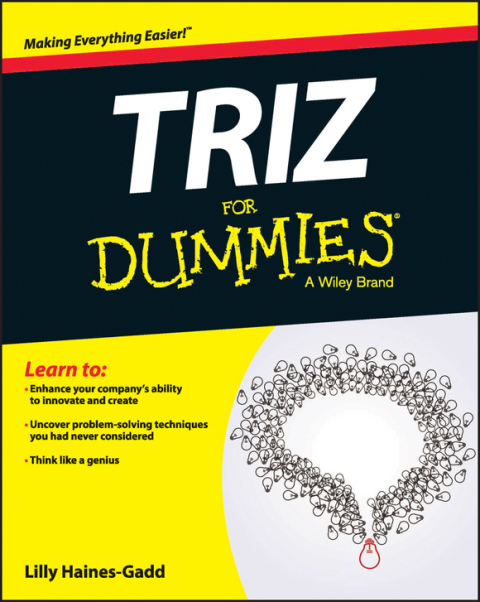Description
Efnisyfirlit
- Cover
- Introduction
- About This Book
- Foolish Assumptions
- Icons Used in This Book
- Beyond the Book
- Where to Go from Here
- Part I: Getting Started with TRIZ
- Chapter 1: Going from Zero to TRIZ
- Getting to Know TRIZ
- Starting Your TRIZ Journey
- Mastering TRIZ
- Chapter 2: Understanding the Fundamental TRIZ Philosophy
- Thinking TRIZ
- Understanding the TRIZ Philosophy
- Being Systematic and Creative
- Part II: Opening Your TRIZ Toolbox
- Chapter 3: Solving Contradictions with the 40 Inventive Principles
- Uncovering and Understanding Unresolved Conflicts
- Solving Technical Contradictions
- Getting to Grips with Physical Contradictions
- Clever Tricks to Outsmart Contradictions: Using the 40 Inventive Principles
- Chapter 4: Applying the Trends of Technical Evolution
- Looking More Closely at the Trends
- Applying the Trends
- Applying the Trends More Generally
- Using the Trends to Create Strong Patents
- Chapter 5: Improving Ideality by Using Resources
- Understanding the Ideality Equation: How TRIZ Defines Value
- Understanding the Links Between Benefits, Functions and Solutions
- Thinking Resourcefully
- Chapter 6: Using the TRIZ Effects Database
- Thinking Innovatively with the Prism of TRIZ
- Using the Database of Scientific Effects
- Inventing with TRIZ
- Part III: Thinking Like a Genius
- Chapter 7: Breaking Psychological Inertia with the TRIZ Creativity Tools
- Recognising Psychological Inertia
- Appreciating the Benefits of Psychological Inertia
- Beating Psychological Inertia
- Understanding and Solving Problems Using Smart Little People
- Stretching Your Thinking with Size–Time–Cost
- Chapter 8: Thinking in Time and Scale
- Stretching Your Thinking in Time and Scale
- Understanding Problems in Time and Scale
- Finding Novel Solutions in Time and Scale
- Learning to Think in Time and Scale
- Chapter 9: Living in Utopia (then Coming Back to Reality)
- Defining the Ideal Outcome
- Taking a Step Towards Reality with Ideal Systems
- Making Sensible Decisions by Considering All Benefits, Costs and Harms
- Chapter 10: Problem Solving and Being Creative with Others
- Going for What You Really Want
- Thinking in Extremes
- Being Persistent in the Face of Failure
- Sharing and Developing Ideas with Other People
- Part IV: Understanding, Defining and Solving Difficult Problems with TRIZ
- Chapter 11: Applying the TRIZ Problem-Solving Process
- Logically and Systematically Solving Problems
- Climbing the Problem-Solving Steps
- Defining your problem correctly
- Generating Solutions
- Ranking and Developing Solutions
- Solving Difficult Problems Effectively in a Team
- Chapter 12: Getting to Grips with Your Problems with Function Analysis
- Making Complex Problems Simple
- Building a Function Analysis Diagram
- Uncovering Conflicts: Putting Contradictions in Context
- Understanding How Everything Fits Together
- Using Function Analysis
- Chapter 13: Solving Problems using the TRIZ Standard Solutions
- Defining a Subject–action–Object
- Categorising Problems
- Dealing with Harmful Actions
- Improving Insufficient Actions
- Measuring and Detecting
- Applying the Standard Solutions
- Chapter 14: Trimming for Elegant, Low-Cost Solutions
- Making Things Better and Cheaper
- Creating Elegant Solutions
- Trimming to Infinity and Beyond
- Trimming to Create Strong Intellectual Property
- Part V: The Part of Tens
- Chapter 15: Ten Pitfalls to Avoid
- Thinking TRIZ Doesn’t Apply to You
- Waiting for the ‘Right’ Problem
- Starting Too Big
- Tackling Problems for Which You Can’t Implement Solutions
- Tackling Problems without Involving the Problem Owner
- Trying to Solve Problems When You Don’t Understand the Issue or the Technology
- Trying to Solve Problems When You Lack Crucial Knowledge
- Working on a Problem That’s Already Been Solved
- Undertaking TRIZ by Stealth
- Giving Up Too Soon
- Chapter 16: Ten Tips for Getting Started with TRIZ
- Learn It
- Use It
- Start Small
- Attend a Workshop
- Think and Talk TRIZ
- Find a Friend
- Fail Safely
- Be Bold
- Fail Better
- Reflect
- Part VI: Appendixes
- Appendix A: The 40 Inventive Principles
- Inventive Principle 1: Segmentation
- Inventive Principle 2: Taking Out
- Inventive Principle 3: Local Quality
- Inventive Principle 4: Asymmetry
- Inventive Principle 5: Merging
- Inventive Principle 6: Multi-Function
- Inventive Principle 7: Nested Doll
- Inventive Principle 8: Counterweight
- Inventive Principle 9: Prior Counteraction
- Inventive Principle 10: Prior Action
- Inventive Principle 11: Cushion in Advance
- Inventive Principle 12: Equal Potential
- Inventive Principle 13: The Other Way Round
- Inventive Principle 14: Spheres and Curves
- Inventive Principle 15: Dynamism
- Inventive Principle 16: Partial or Excessive Action
- Inventive Principle 17: Another Dimension
- Inventive Principle 18: Mechanical Vibration
- Inventive Principle 19: Periodic Action
- Inventive Principle 20: Continuous Useful Action
- Inventive Principle 21: Rushing Through
- Inventive Principle 22: Blessing in Disguise
- Inventive Principle 23: Feedback
- Inventive Principle 24: Intermediary
- Inventive Principle 25: Self-service
- Inventive Principle 26: Copying
- Inventive Principle 27: Cheap, Short-Living Objects
- Inventive Principle 28: Replace Mechanical System
- Inventive Principle 29: Pneumatics and Hydraulics
- Inventive Principle 30: Flexible Membranes and Thin Films
- Inventive Principle 31: Porous Materials
- Inventive Principle 32: Colour Change
- Inventive Principle 33: Uniform Material
- Inventive Principle 34: Discarding and Recovering
- Inventive Principle 35: Parameter Change
- Inventive Principle 36: Phase Changes
- Inventive Principle 37: Thermal Expansion
- Inventive Principle 38: Boosted Interactions
- Inventive Principle 39: Inert Atmosphere
- Inventive Principle 40: Composite Structures
- Appendix B: The Contradiction Matrix
- Appendix C: The 39 Parameters of the Contradiction Matrix
- Appendix D: The Separation Principles
- Appendix E: The Oxford TRIZ Standard Solutions
- Solutions for Dealing with Harms
- Solutions for Improving Insufficiency
- Solutions for Detection and Measurement
- About the Author
- Cheat Sheet
- Advertisement Page
- Connect with Dummies
- End User License Agreement






Reviews
There are no reviews yet.